‘Lincoln’ Category
» posted on Sunday, June 23rd, 2013 by Linda Lou Burton
Go Big Red
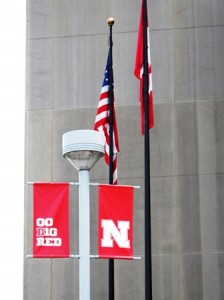 Linda Burton posting from Lincoln, Nebraska – I stared at them all during lunch. Red back-to-back “N”s all across the wall in a Mexican restaurant that didn’t have “N” in its name. So I finally asked what they meant. My server just stared at me. “Nebraska,” she finally answered, as though she couldn’t believe anyone would have to ask. “This is Nebraska. Go Big Red.” Properly chagrined, I replied, “Well I knew that. I just didn’t know why the “N”s were here.” “They are everywhere,” she laughed. “Everything in Lincoln is Nebraska Red.” And so it is; the University of Nebraska in Lincoln, the state’s oldest and largest university and the flagship of the University of Nebraska system. It all started back in 1869, two years after statehood, when it was chartered by the legislature as a land grant university under the 1862 Morrill Act. It was laid out on four city
Linda Burton posting from Lincoln, Nebraska – I stared at them all during lunch. Red back-to-back “N”s all across the wall in a Mexican restaurant that didn’t have “N” in its name. So I finally asked what they meant. My server just stared at me. “Nebraska,” she finally answered, as though she couldn’t believe anyone would have to ask. “This is Nebraska. Go Big Red.” Properly chagrined, I replied, “Well I knew that. I just didn’t know why the “N”s were here.” “They are everywhere,” she laughed. “Everything in Lincoln is Nebraska Red.” And so it is; the University of Nebraska in Lincoln, the state’s oldest and largest university and the flagship of the University of Nebraska system. It all started back in 1869, two years after statehood, when it was chartered by the legislature as a land grant university under the 1862 Morrill Act. It was laid out on four city 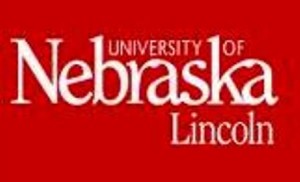 blocks and had one building. Today two campuses in Lincoln cover 2,815 acres and the university is organized into eight colleges with over 100 buildings and research facilities. City Campus is north of downtown, and south of the old fairgrounds; East Campus is two miles east-northeast of that. In addition, UNL has a 25-acre technology park on the north side of town, supplied by modern high-tech laboratories on artificial intelligence, the first
blocks and had one building. Today two campuses in Lincoln cover 2,815 acres and the university is organized into eight colleges with over 100 buildings and research facilities. City Campus is north of downtown, and south of the old fairgrounds; East Campus is two miles east-northeast of that. In addition, UNL has a 25-acre technology park on the north side of town, supplied by modern high-tech laboratories on artificial intelligence, the first  endeavor of its kind in the state. The Nebraska Innovation Campus, on 249 more acres, is being planned to house agricultural biotechnology and other life science research. And then there is the athletic program. The Cornhuskers football team has won 46 conference and five national championships; the women’s volleyball team has won three national championships. Memorial Stadium holds 85,000 and sells out every game. This year eight home games are scheduled; great joy in Lincoln over that. » read more
endeavor of its kind in the state. The Nebraska Innovation Campus, on 249 more acres, is being planned to house agricultural biotechnology and other life science research. And then there is the athletic program. The Cornhuskers football team has won 46 conference and five national championships; the women’s volleyball team has won three national championships. Memorial Stadium holds 85,000 and sells out every game. This year eight home games are scheduled; great joy in Lincoln over that. » read more
» posted on Friday, June 21st, 2013 by Linda Lou Burton
Looking Up
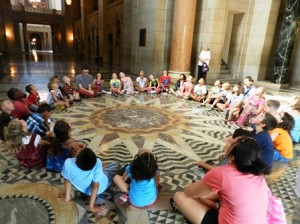 Linda Burton posting from Lincoln, Nebraska – “Sit around this circle and look up,” Jamison the Tour Guide instructed the kids. They plopped to the floor and so did he, right in their midst. The rest of us kept standing; an appropriate entourage of parents, one grandma, a couple from Germany, and me. We exchanged glances, acknowledging our inability to gracefully plop; then grandma and I found a bench. Meanwhile, the kids kept looking up, and up, as Jamison pointed and told stories. “See the man behind the plow?” he said, and directed everyone to look at a large mural on the wall high above our heads. The children nodded. “The grass is
Linda Burton posting from Lincoln, Nebraska – “Sit around this circle and look up,” Jamison the Tour Guide instructed the kids. They plopped to the floor and so did he, right in their midst. The rest of us kept standing; an appropriate entourage of parents, one grandma, a couple from Germany, and me. We exchanged glances, acknowledging our inability to gracefully plop; then grandma and I found a bench. Meanwhile, the kids kept looking up, and up, as Jamison pointed and told stories. “See the man behind the plow?” he said, and directed everyone to look at a large mural on the wall high above our heads. The children nodded. “The grass is 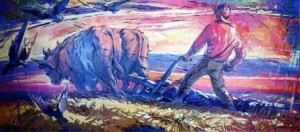 very thick,” he explained, “and he is digging up sections of it with his plow, and stacking the sections. Do you know what he did with the large sections of grass, or sod?” They did not know. “They built houses,” he said joyfully, “sod houses! They stacked it up and made houses from it. Now, why do you think they used sod instead of trees?” The children looked at each other, and looked again at the mural. They did not know the answer. “We have trees in Lincoln now,” he continued, “but many years ago, there were no trees, just prairie grass. No trees! Somebody planted all the trees you see today. There was no wood to build with, so the
very thick,” he explained, “and he is digging up sections of it with his plow, and stacking the sections. Do you know what he did with the large sections of grass, or sod?” They did not know. “They built houses,” he said joyfully, “sod houses! They stacked it up and made houses from it. Now, why do you think they used sod instead of trees?” The children looked at each other, and looked again at the mural. They did not know the answer. “We have trees in Lincoln now,” he continued, “but many years ago, there were no trees, just prairie grass. No trees! Somebody planted all the trees you see today. There was no wood to build with, so the 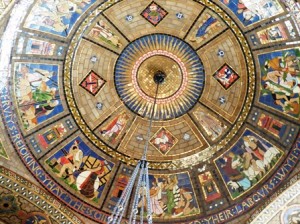 settlers used what they had. And that was sod.” There was a group “ohh” from the children as they thought about that. Jamison continued with the beginnings of Nebraska, pictured right there in the vestibule of the capitol. The capitol’s art is “themed” from beginning to end, reflecting the values of the people of Nebraska. There’s hushed behavior here; the building feels cathedral-like; especially looking up. » read more
settlers used what they had. And that was sod.” There was a group “ohh” from the children as they thought about that. Jamison continued with the beginnings of Nebraska, pictured right there in the vestibule of the capitol. The capitol’s art is “themed” from beginning to end, reflecting the values of the people of Nebraska. There’s hushed behavior here; the building feels cathedral-like; especially looking up. » read more
» posted on Wednesday, June 19th, 2013 by Linda Lou Burton
Life Is Right
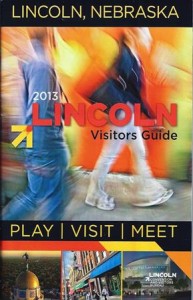 Linda Burton posting from Lincoln, Nebraska – “I’m not stuck-up. I’m just deaf.” Such was the comment made to me by the gentleman to my left, as his wife leaned across to chat. We each were waiting for a table; the restaurant was crowded and a conversation had naturally begun. At least, between the wife and me. Until the husband chimed in, concluding, “That’s why I’m not talking.” He looked directly in my eyes as he spoke, and gave me a quirky smile as though to apologize. His wife smiled too, and gave him a love pat on the shoulder; I smiled back and thanked him for saying that. It was a comfortable moment. And not unusual for Lincoln, I’m finding. Everyone comes across friendly, and open. If people in a community are friendly, and open, then is it logical to conclude that the people in that community are happy? That life is right? The Lincoln Chamber of Commerce believes it; in fact, they have set up a website – www.lifeisright.com – to serve as an outlet for local residents, and visitors, to express why they believe life feels “right” in Lincoln. At “Shout Lincoln” you can record your comments; at “Picture Lincoln” you can add your favorite Lincoln photos. And “Brand Lincoln” is an innovative approach that helps local businesses and organizations customize the Lincoln logo to perfectly fit their
Linda Burton posting from Lincoln, Nebraska – “I’m not stuck-up. I’m just deaf.” Such was the comment made to me by the gentleman to my left, as his wife leaned across to chat. We each were waiting for a table; the restaurant was crowded and a conversation had naturally begun. At least, between the wife and me. Until the husband chimed in, concluding, “That’s why I’m not talking.” He looked directly in my eyes as he spoke, and gave me a quirky smile as though to apologize. His wife smiled too, and gave him a love pat on the shoulder; I smiled back and thanked him for saying that. It was a comfortable moment. And not unusual for Lincoln, I’m finding. Everyone comes across friendly, and open. If people in a community are friendly, and open, then is it logical to conclude that the people in that community are happy? That life is right? The Lincoln Chamber of Commerce believes it; in fact, they have set up a website – www.lifeisright.com – to serve as an outlet for local residents, and visitors, to express why they believe life feels “right” in Lincoln. At “Shout Lincoln” you can record your comments; at “Picture Lincoln” you can add your favorite Lincoln photos. And “Brand Lincoln” is an innovative approach that helps local businesses and organizations customize the Lincoln logo to perfectly fit their 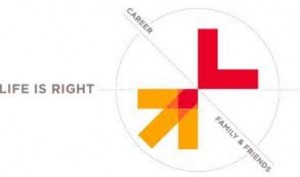 needs. It’s a simple but very eye-catching look: an arrow pointing upward, to symbolize growth and progress, and pointing towards the Lincoln “L.” Rationally, the three segments of the arrow represent the people, places, and events that make up the community; emotionally, they stand for the success, comfort and fun you have when you live in Lincoln. And where the arrow meets the “L” is the sweet spot; that’s what signifies that “life is right” in Lincoln. » read more
needs. It’s a simple but very eye-catching look: an arrow pointing upward, to symbolize growth and progress, and pointing towards the Lincoln “L.” Rationally, the three segments of the arrow represent the people, places, and events that make up the community; emotionally, they stand for the success, comfort and fun you have when you live in Lincoln. And where the arrow meets the “L” is the sweet spot; that’s what signifies that “life is right” in Lincoln. » read more
» posted on Monday, June 17th, 2013 by Linda Lou Burton
Two For One, Special
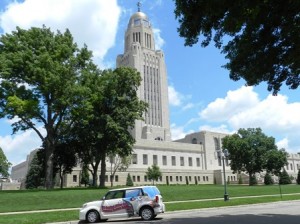 Linda Burton posting from Lincoln, Nebraska – Look carefully at my picture of the Nebraska state capitol. Do you notice anything unusual? I thought it was nice that free parking is available close by, and a sign at the bottom of the steps shows the open hours and the ADA entrance; that’s unusual, but not what I’m referring to. I’m talking about a feature unlike any other capitol in the United States. Thirty-seven capitol buildings have domes and four are skyscraper-highrise in construction. But the Nebraska capitol fits into both categories! A domed highrise, unique
Linda Burton posting from Lincoln, Nebraska – Look carefully at my picture of the Nebraska state capitol. Do you notice anything unusual? I thought it was nice that free parking is available close by, and a sign at the bottom of the steps shows the open hours and the ADA entrance; that’s unusual, but not what I’m referring to. I’m talking about a feature unlike any other capitol in the United States. Thirty-seven capitol buildings have domes and four are skyscraper-highrise in construction. But the Nebraska capitol fits into both categories! A domed highrise, unique 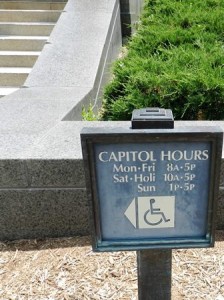 and striking. It’s not the tallest of the three built in the 30’s when economic considerations were primary and Art deco was the design of choice, nor was it the least expensive to build, but it incorporates features that meet the needs of Nebraska citizens with both efficiency and beauty. And behind every element that is functional lies a deeper meaning of what Nebraska is all about. Take that golden dome, for instance. It is symbolic of the sun, so central to the weather of the prairie state; its reflective surface even changes
and striking. It’s not the tallest of the three built in the 30’s when economic considerations were primary and Art deco was the design of choice, nor was it the least expensive to build, but it incorporates features that meet the needs of Nebraska citizens with both efficiency and beauty. And behind every element that is functional lies a deeper meaning of what Nebraska is all about. Take that golden dome, for instance. It is symbolic of the sun, so central to the weather of the prairie state; its reflective surface even changes 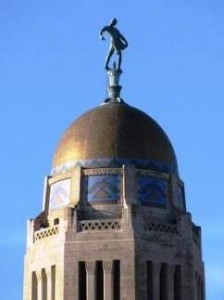 color as the weather changes. Below that, the frieze around the drum depicts thunderbirds, an American Indian symbol of thunder. Atop the dome stands the Sower, arm extended as he spreads the seed in a northwesterly direction, where most of Nebraska’s farmlands lie. These three elements together represent weather and agriculture; symbolically, they are an homage to civilizations of the past – Egyptians, American Indians, and the European settlers. From top to bottom the theme carries through, yet all the spaces are usable, and logically arranged. But it’s not just the building that’s unique, it’s also what happens inside. I’m talking about the legislative system – the only one in the country that is unicameral. » read more
color as the weather changes. Below that, the frieze around the drum depicts thunderbirds, an American Indian symbol of thunder. Atop the dome stands the Sower, arm extended as he spreads the seed in a northwesterly direction, where most of Nebraska’s farmlands lie. These three elements together represent weather and agriculture; symbolically, they are an homage to civilizations of the past – Egyptians, American Indians, and the European settlers. From top to bottom the theme carries through, yet all the spaces are usable, and logically arranged. But it’s not just the building that’s unique, it’s also what happens inside. I’m talking about the legislative system – the only one in the country that is unicameral. » read more
» posted on Saturday, June 15th, 2013 by Linda Lou Burton
In The Neighborhoods
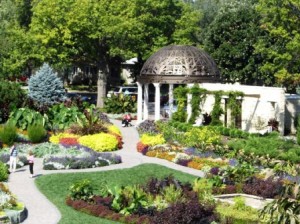 Linda Burton posting from Lincoln, Nebraska – It once was named Lancaster, but its name was changed in a political ploy. It wasn’t built on a large body of water or near any mountains. Without those moderating influences it has a highly variable climate, subject to bitter cold in the winter and heat waves during the summer. Frequent thunderstorms often produce tornadoes and blizzards are possible in the winter. It has little development outside its city limits and no contiguous suburbs. It doesn’t sound like a very appealing place to live, does it? But wait.
Linda Burton posting from Lincoln, Nebraska – It once was named Lancaster, but its name was changed in a political ploy. It wasn’t built on a large body of water or near any mountains. Without those moderating influences it has a highly variable climate, subject to bitter cold in the winter and heat waves during the summer. Frequent thunderstorms often produce tornadoes and blizzards are possible in the winter. It has little development outside its city limits and no contiguous suburbs. It doesn’t sound like a very appealing place to live, does it? But wait. 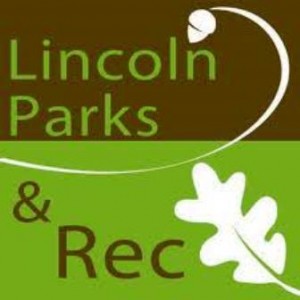 This city, built on gently rolling hills, has over 6,000 acres of parks and natural land, 7 recreation centers, 128 miles of trails, 10 public pools and 5 city golf courses. The goal of the city planners is to have a park area within a half mile walking distance of each residence in the community; in fact, the tagline says “parks and recreation are FUNdamental to the city’s quality of life.” There’s more. A canopy of 125,000 public trees covers the city; 87,000 of them line the 1,217 miles of streets. In fact, the city has been nationally recognized as a Tree City USA by the National Arbor Day
This city, built on gently rolling hills, has over 6,000 acres of parks and natural land, 7 recreation centers, 128 miles of trails, 10 public pools and 5 city golf courses. The goal of the city planners is to have a park area within a half mile walking distance of each residence in the community; in fact, the tagline says “parks and recreation are FUNdamental to the city’s quality of life.” There’s more. A canopy of 125,000 public trees covers the city; 87,000 of them line the 1,217 miles of streets. In fact, the city has been nationally recognized as a Tree City USA by the National Arbor Day 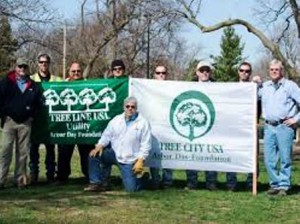 Foundation every year since 1976. And oh yes, the CDC has put it high on the list of “healthiest cities in the USA.” I’m talking about Lincoln, Nebraska, ranked as the 14th most populous capital city with 258,379 (US 2010 Census) residents who are proud to call it home. And it’s been around since 1856, even though it was Lancaster back then. Let me explain what led to the “political ploy” that changed everything. And then I’ll take you around to some of present-day Lincoln’s beautiful neighborhoods. » read more
Foundation every year since 1976. And oh yes, the CDC has put it high on the list of “healthiest cities in the USA.” I’m talking about Lincoln, Nebraska, ranked as the 14th most populous capital city with 258,379 (US 2010 Census) residents who are proud to call it home. And it’s been around since 1856, even though it was Lancaster back then. Let me explain what led to the “political ploy” that changed everything. And then I’ll take you around to some of present-day Lincoln’s beautiful neighborhoods. » read more
» posted on Thursday, June 13th, 2013 by Linda Lou Burton
Itsy Bitsy Spider
 Linda Burton posting from Lincoln, Nebraska – Which frightens you most – spiders or lightning? For me it has always been lightning, like the stuff that welcomed me to Nebraska today in a frenzy of white slashing black over the green prairie to the west. Could I outrun the storm? It was moving west to east; I was traveling south to north; it was a futile contest; I lost. I’ve never seen much lightning before, as I tend to head for cover at the sound of the first thunderclap. Today I had no choice but to look. I had to keep my eyes on the road and sky; there was no place to stop; only open prairie.
Linda Burton posting from Lincoln, Nebraska – Which frightens you most – spiders or lightning? For me it has always been lightning, like the stuff that welcomed me to Nebraska today in a frenzy of white slashing black over the green prairie to the west. Could I outrun the storm? It was moving west to east; I was traveling south to north; it was a futile contest; I lost. I’ve never seen much lightning before, as I tend to head for cover at the sound of the first thunderclap. Today I had no choice but to look. I had to keep my eyes on the road and sky; there was no place to stop; only open prairie. 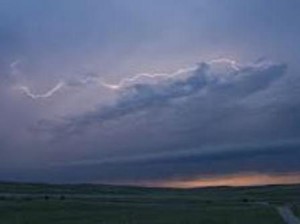 By sheer force nature made me realize just what amazing tricks it can do. Cloud to ground! Cloud to cloud! I counted more than a hundred streaks before the storm engulfed me with rain and then I couldn’t see a thing. Until I reached my hotel and flipped the blinker to signal left. That’s when I saw the spider and forgot the storm. My priorities changed! It was a substantial-looking brown spider, directly above the steering column and crawling down. I grabbed the first thing I could – a piece of paper with today’s driving directions – and smashed it against the spider. I missed. The spider fell to my feet. I’d heard tales
By sheer force nature made me realize just what amazing tricks it can do. Cloud to ground! Cloud to cloud! I counted more than a hundred streaks before the storm engulfed me with rain and then I couldn’t see a thing. Until I reached my hotel and flipped the blinker to signal left. That’s when I saw the spider and forgot the storm. My priorities changed! It was a substantial-looking brown spider, directly above the steering column and crawling down. I grabbed the first thing I could – a piece of paper with today’s driving directions – and smashed it against the spider. I missed. The spider fell to my feet. I’d heard tales 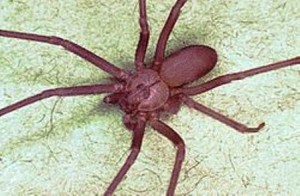 of wrecks caused by insects; although the storm raged around me and traffic whizzed by on either side, my basic instinct was to jump out of the car. But I didn’t. I made it into the hotel parking lot and got the cats and myself inside out of the storm, where I immediately began to read up on spiders. Because after all, that healthy brown arachnid was still in my car. » read more
of wrecks caused by insects; although the storm raged around me and traffic whizzed by on either side, my basic instinct was to jump out of the car. But I didn’t. I made it into the hotel parking lot and got the cats and myself inside out of the storm, where I immediately began to read up on spiders. Because after all, that healthy brown arachnid was still in my car. » read more
